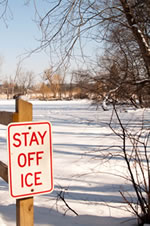Water and Ice Safety

Photo courtesy of John Langholz.
What may appear to be frozen over lakes or ponds can be inviting spots for ice skaters and children who would like to explore during Missouri’s winter months. Even in bitter cold temperatures, ice conditions on bodies of water can be extremely uncertain. The only guaranteed safe skating ice is at a skating rink.
Ice found on natural bodies of water raises the risk of danger due to natural variables. There is no way to judge the strength and safety of ice by looking at it or by the temperature of the day. Fluctuating temperatures, exposure to sunlight and other factors affect the consistency of the ice. It can be a several inches thick in one spot and only an inch thick 10 feet away. Be especially wary of ice covered with snow. Snow can hide cracks and weaknesses in open ice. Parents should educate their children about the danger of going out onto a frozen body of water, including never following a friend or a pet into these potential danger zones.
Basic tips
- Parents should always supervise children skating or playing on or near ice. Educate them on the risks of playing on ice, and outfit them with lifejackets. Never leave children alone on or near ice covered bodies of water.
- Adults should prepare before going on ice. Wait to walk out onto ice until there is a minimum of four inches of clear, solid ice measured from multiple locations. Start measurements in an area where the water is shallow. If the thickness in the shallow area is less than three inches, do not walk on the ice.
- Take someone with you, wear a life jacket, and bring safety equipment, including a cell phone, in case of an emergency.
- Always keep your pets on a leash near frozen bodies of water. If a pet falls through the ice, do not attempt to rescue your pet, call 9-1-1 or go for help.
- Stay clear of white ice. White ice contains air and snow within it, therefore, making it weaker.
- Stay off river ice. Currents can quickly change the thickness of ice, making it more fragile.

When Someone Falls Through Ice
- If you come across someone who has fallen through the ice, don’t attempt a rescue yourself. Call 9-1-1 or immediately or go for help. Local public safety officers have proper training and equipment to handle ice emergencies.
- If the ice did not support the victim’s weight, it will not support you. Avoid going onto the ice to attempt a rescue, but extend a ladder, rope, jumper cables, or tree branch to the victim along with something that will keep them afloat.
- Once the person is rescued from the cold water, help the victim into dry clothes as soon as possible. If dry clothes aren’t an option, leave the wet clothes on for insulation to trap body heat.
- Transport the victim to get medical attention if necessary.
If You Fall Through Ice
- Remain calm, and try not to panic. The body will undergo cold water shock when suddenly immersed in cold water, and you will experience an increase in heart rate and blood pressure.
- Face the direction you came from and spread your arms out on the unbroken ice. Kick your feet and try to pull yourself onto the ice.
- Once out of the cold water, remain lying on the ice (do not attempt to stand) to keep your weight distributed and avoid breaking through the ice. Roll away from the hole and crawl back to solid land. This keeps your weight distributed.
- Treat yourself for hypothermia and seek medical attention.
